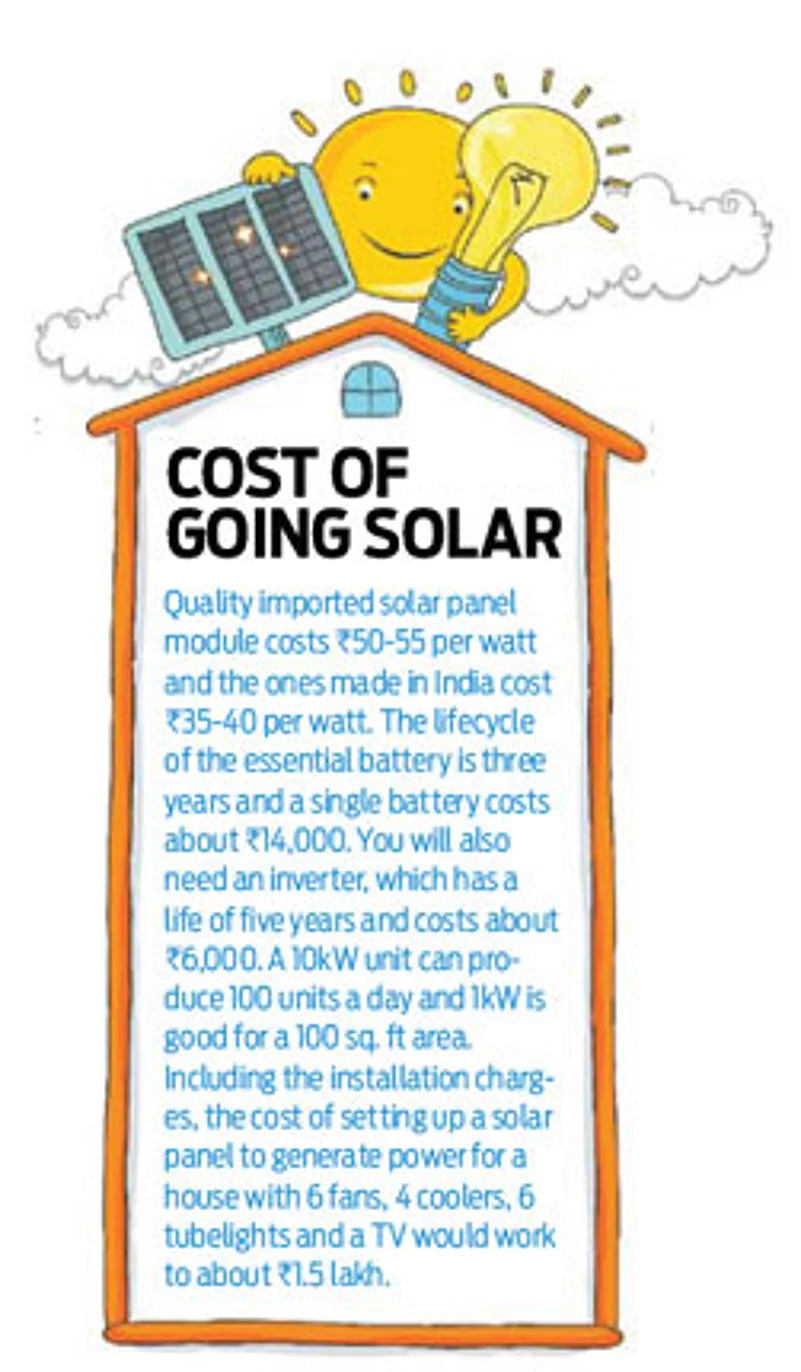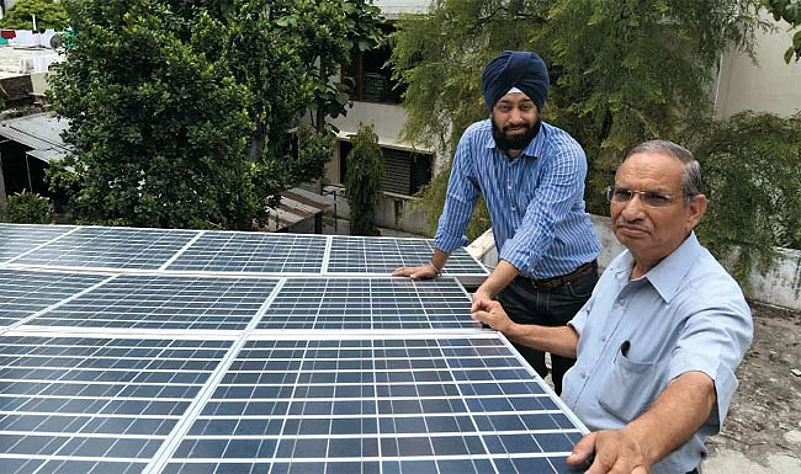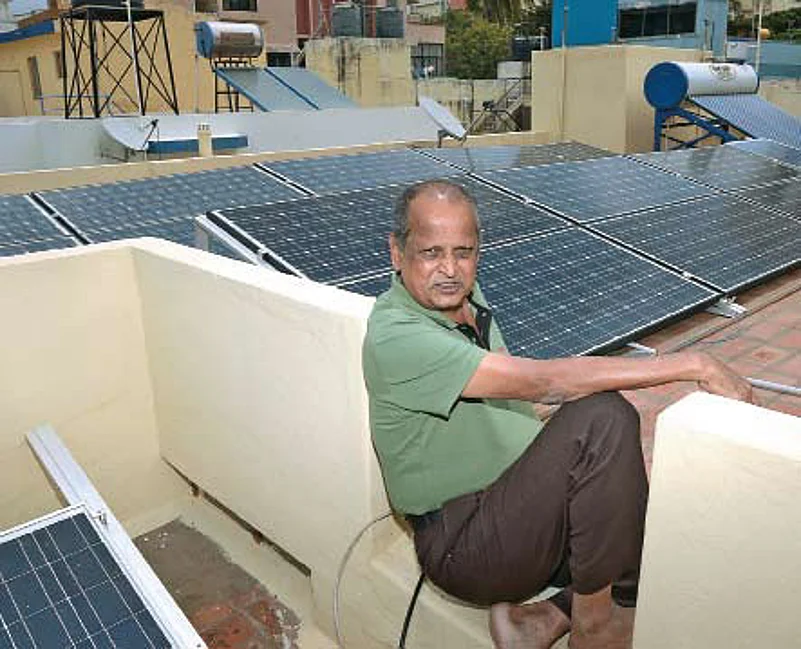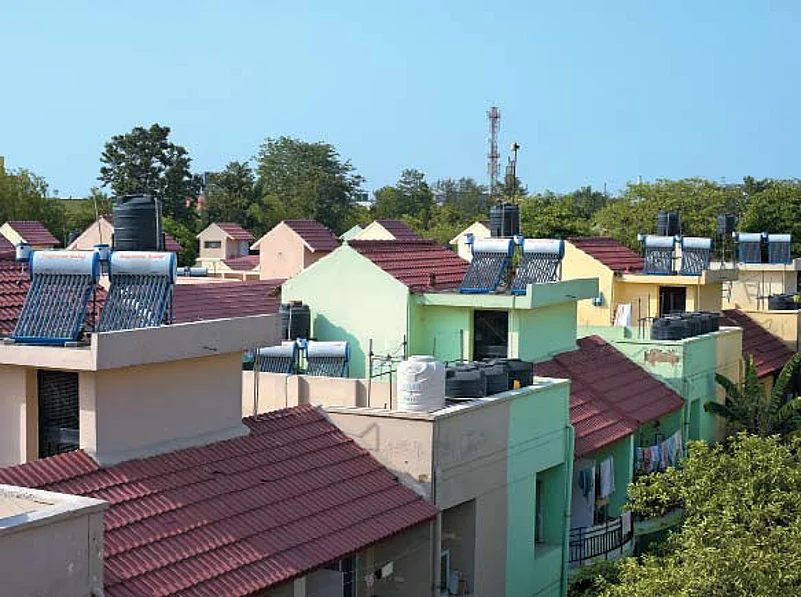In April 2015, the IPL matches played at the Chinnaswamy stadium in Bengaluru were different from what they had been in the past—the stadium was solar-powered and except for the floodlights, the stadium used its own generated power. The government’s push on generating solar power has found takers in the corporate sector and also at homes. More people are looking to set-up a solar-powered panel to generate power in not just smaller towns and villages, but also in big cities. Villages and small towns in Punjab, Rajasthan, Gujarat and Karnataka are now full of solar panels, even as big cities look for ways to tackle their power problem.
Advertisement
Ghaziabad resident Gagandeep Singh, 39, has been a victim of power woes for years, which he has been trying to address with the usual alternates. "Electricity is a problem and so far I have tried invertors and generators, and the result has been an increasing recurring cost, something I wanted to put an end to." He has now got a solar panel installed in his house, which promises to provide eight hour back-up to run fans, TV, coolers, tubelights and other essential electrical gadgets at home. There are many others like him who are fed up with power cuts and are exploring ways to generate their own power.
Advertisement
What has also precipitated matters is the rising cost of electricity. Solar panels provide a very good alternative and the Ministry of New and Renewable Energy (MNRE) is vigorously promoting solar power generation by providing capital subsidy to individuals and organisations buying solar panels.
Harnessing solar energy
Using the sun to power your home helps reduce your electricity bills, and given its clear source, it also shows well on the carbon footprint front. The government in its own way is providing subsidies to those interested in putting up solar panels and is also facilitating it through the Solar Energy Corporation of India (SECI).
The long life of solar panels offsets the high initial costs; for instance, solar panels come with a warranty of 25 years and continue to produce around 80 per cent of the designed capacity even after that.
As there is no dearth of sunlight in most parts of India throughout the year, solar power generation is an automatic choice. Delhi-based Dr Sunita Sarin has experienced solar power in the government quarters where she lives. "This colony has adopted solar power generation, which is used for street lights and also homes. The entire experience has been very positive and there is tremendous reduction in the electricity bills than what we were paying earlier," she says. Several colonies are now moving to generate solar power and use it for common spaces.
Advertisement

The initial cost in setting up solar panels is high, but when one takes into account the savings, the return on investment is very commendable.
For instance, if you assume consumption of 10 units, which is 10kW of electricity daily, and install a 1kW solar panel on your roof, the cost will be roughly about Rs 1 lakh. Going by the average life of about 25 years of a solar panel, the cost works to Rs 4,000 a year. A 1kW panel provides approximately five units of electricity per day. Assuming Rs 3 per unit as the cost of power from the electricity board, by generating your own power you would save Rs 5,500 annually, which takes care of the set-up cost.
Advertisement
Nuts and bolts
What you need to make use of the freely available sun rays is an open roof with about 100 sq. ft to place the panels on metal frames. You will also need an inverter and suitable battery for solar charging. There are several small and big players who are providing turnkey solutions right from designing to mounting and setting up the solar panel at your house in order to make it self-sufficient with power generation. While most household appliances can run on solar power, air conditioners are best avoided due to their higher power consumption.
All components come with a warranty, something that one should factor in depending on the set-up one goes with. There are also insurance policies available to address damagerelated risk to panels and other components. What one needs to ensure for optimal power generation is to keep the unit safe and maintain it with timely cleaning and routine check-ups by the installing agency.
Advertisement
There are no additional costs on routine maintenance, which is typically included in the initial set-up cost.
Although there is a possibility to generate more power than what one needs for personal use, very few people use their roofs like a solar power farm. If one puts up more panels, it will be possible to not just generate additional power, but also to earn by way of selling it (See: Rooftop money spinner). Such power generated in excess can be sold to the grid, which means, if planned well and executed smartly, the entire process can be converted into a moneymaking venture by just setting up a solar energy plant on top of a house.
Advertisement
For the average Indian, power consumption varies through the year, which means in months when the overall power consumption is low; the savings on account of having a solar power set increases that much more. "Between the months of November and February when the winter sets in, we don’t use electricity from the main grid; the solar generated power is sufficient for our routine use with the grid power usage being minimal,, if at all the need arises" explains Singh. It does pay to smartly use solar energy to power the appliances and gadgets in your home, especially in times when electricity consumption is only going up and so is the cost of generating it through conventional ways.

Rooftop money spinner
At 68, Bengaluru-based H.N.A. Prasad has the curiosity and acumen that may embarrass many who are half his age. Passionate about alternate energy, this well-travelled sexagenarian had his first brush with solar power over three decades ago when he got into manufacturing solar water heaters.
What commenced as a belief in generating power on his own to sustain his household three years ago has turned into a power generating unit which is also paying him now.

No wonder, these days, he has at least one visitor a day to enquire how solar panels are installed and how the whole set-up works. "Yes, the cost of installation is high and there are inefficiencies in the installation process if one is not clued in, still the generated power is of good quality and the per unit cost is low," he says.
Almost all the electrical appliances that one may think of like fans, lights, TV and mixers are run on solar power. "I am strongly against storing solar power and hence, I transfer anything in excess of my usage to the grid," he explains. The outcome—an average earning of Rs 4,000 a month from the grid.His household electricity consumption of 150 units a month is mostly generated by the solar panels he has installed. Although he could have the entire household run on solar generated electricity, he consumes 90 units from what he generates and 60 units from the state electricity board.
"I don’t think that anywhere can I find a way to make Rs 48,000 per year other than just by generating solar power, and that’s if the price of energy doesn’t go up," he adds. For him, the Rs 4.5 lakh upfront investment in the hardware and installation is worth the money he will be making in the long run, not to forget the peace of mind of steady power being generated in his home.
Prasad is now lending a hand to NGOs in rural areas and helping them harness solar power and be energy sufficient. "Low-cost clean energy is not only necessary, but the best option for people in rural areas and small towns to harness electricity for their household consumption," he explains.















 Just one email a week
Just one email a week